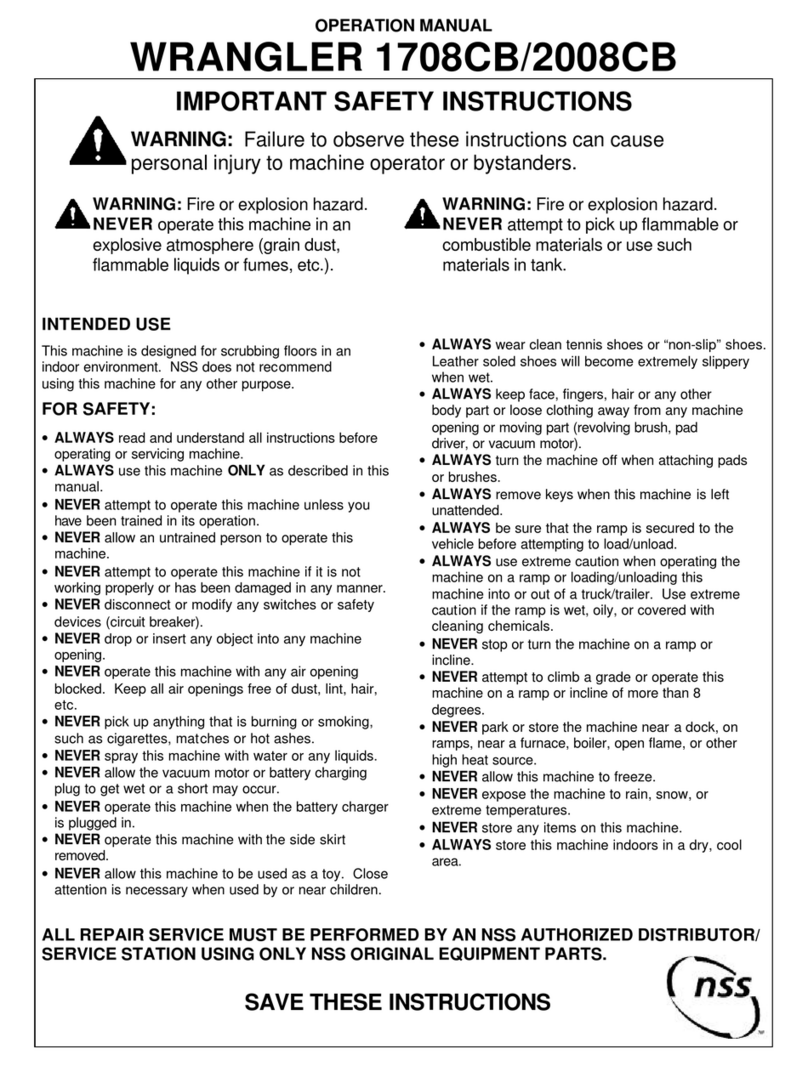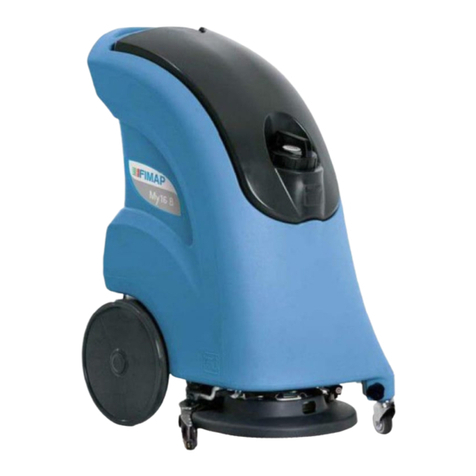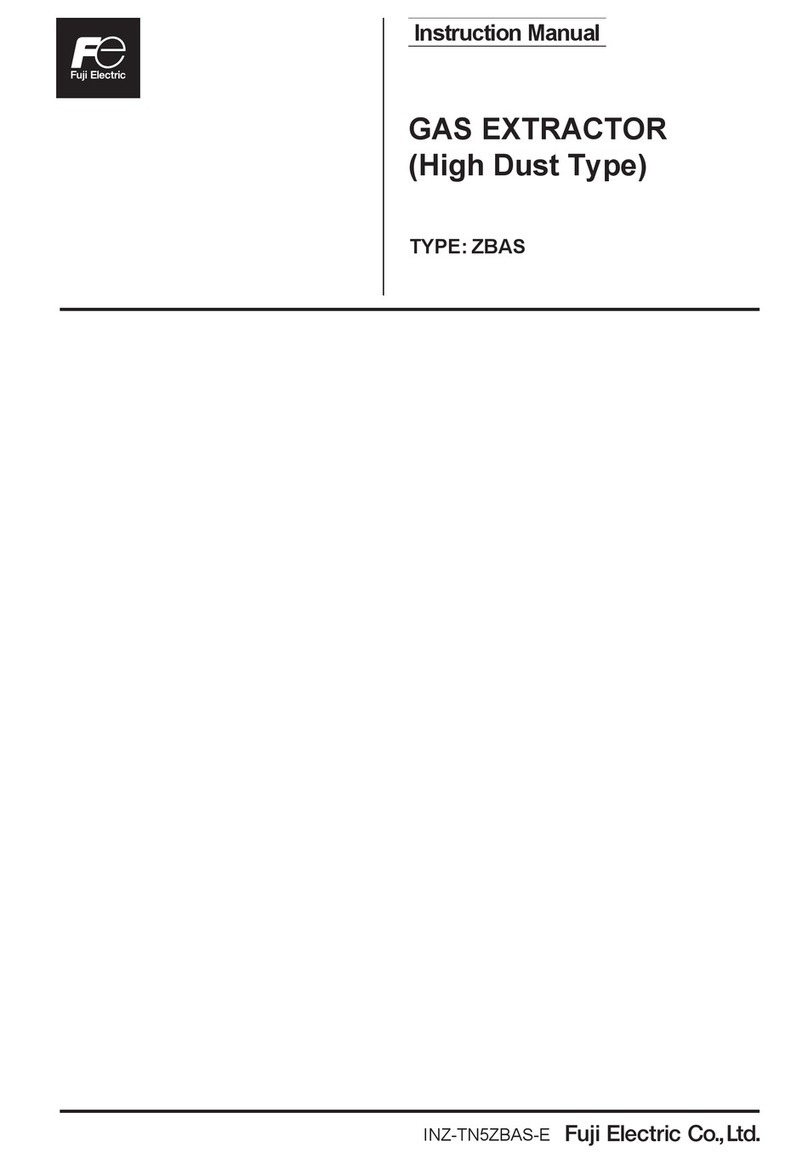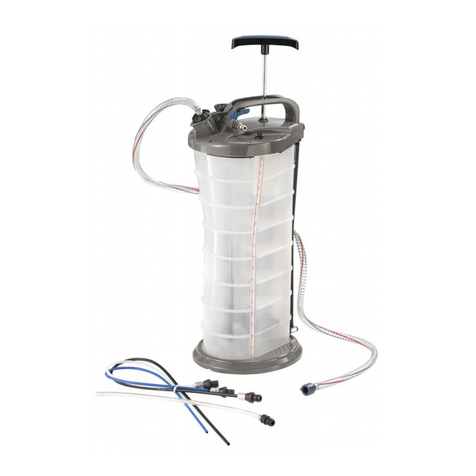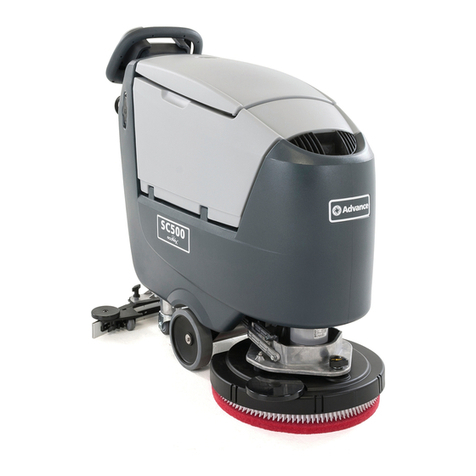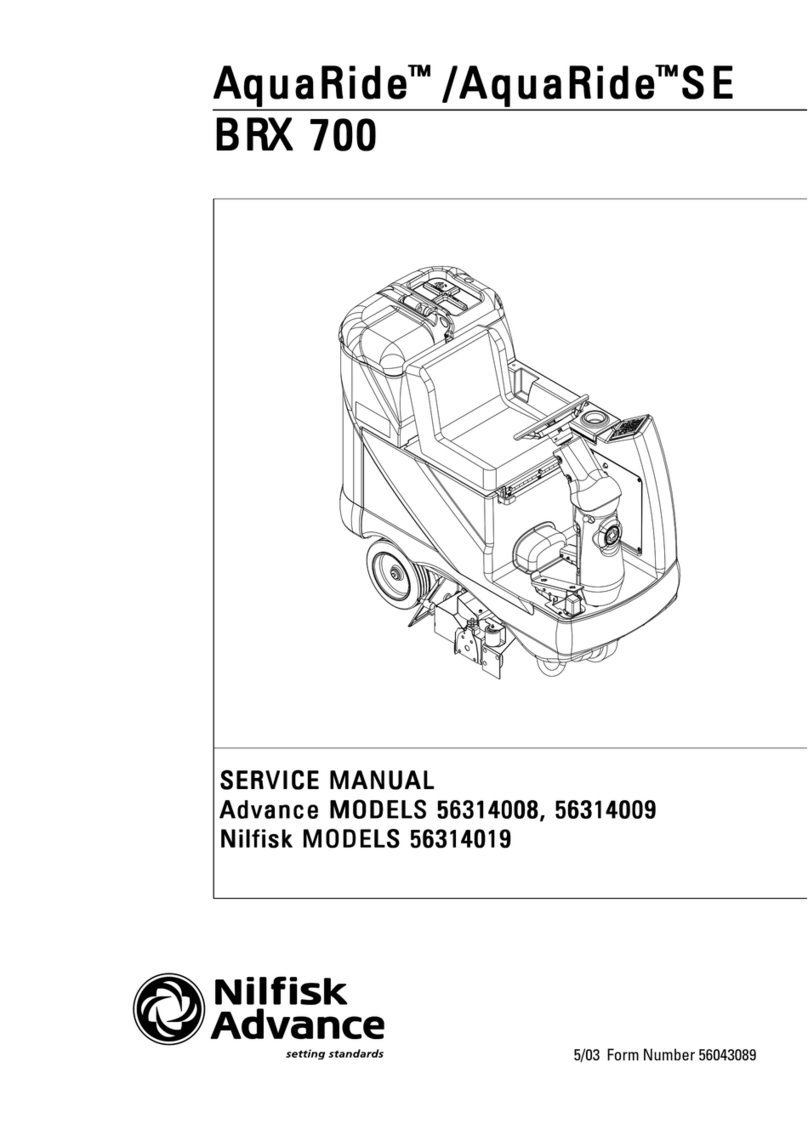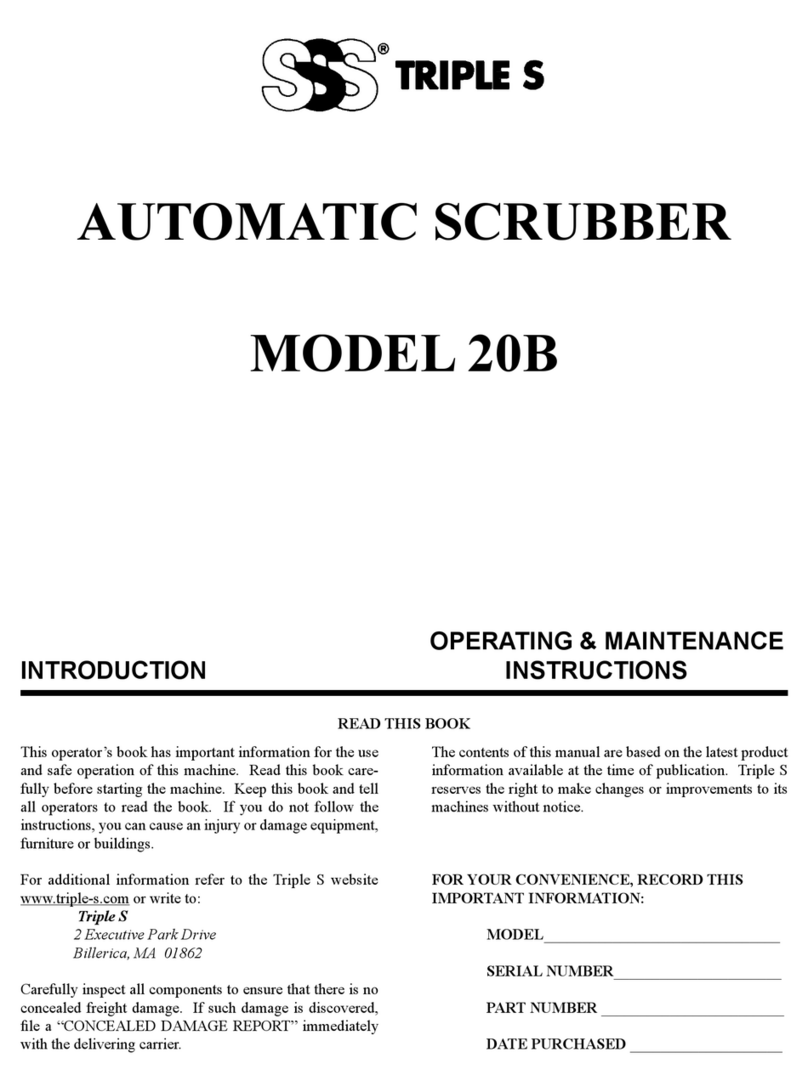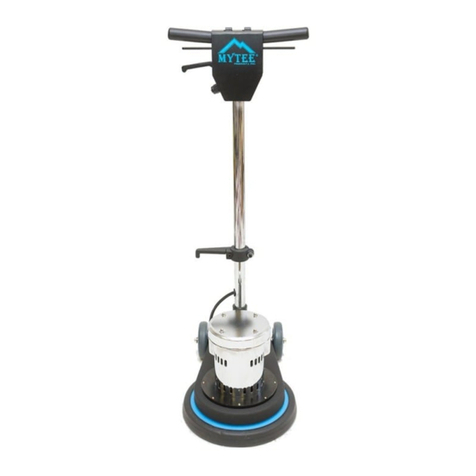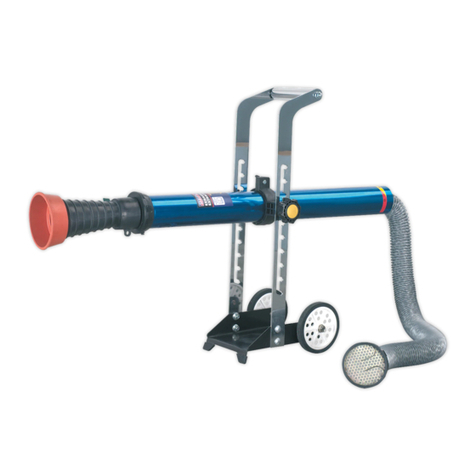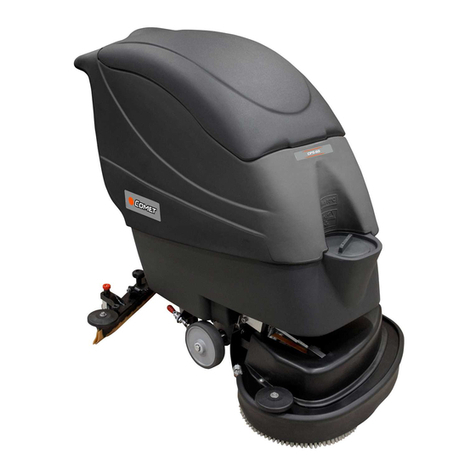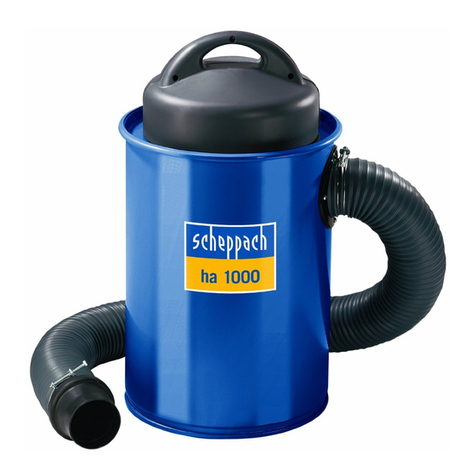NSS Wrangler 2012 AB User manual

Wrangler 2012 AB
Wrangler 2012 DB
Automatic Floor Scrubber/Dryer
Récureuse/sécheuse de planchers automatique
Fregador y secador de pisos automático
OPERATOR MANUAL
MANUEL DE L’OPÉRATEUR
MANUAL DE OPERADOR

ii
Contents
Markings __________________________________________________ 1
Figure 1 ___________________________________________________ 2
Figure 2 ___________________________________________________ 3
Figure 3 ___________________________________________________ 3
Figure 4 ___________________________________________________ 3
Common Machine Components List ______________________________ 3
Figure 5 ___________________________________________________ 4
Figure 6 ___________________________________________________ 4
Machine Control Components List _______________________________ 5
IMPORTANT SAFETY INSTRUCTIONS ____________________________ 6
Battery Safety Information ____________________________________ 6
Battery Charging Safety_______________________________________ 7
GROUNDING OF ELECTRICAL EQUIPPMENT - BATTERY CHARGER _______ 7
Unpacking Instructions _______________________________________ 7
Machine Inspection___________________________________________ 8
Before First Use _____________________________________________ 8
MACHINE COMPONENTS ______________________________________ 8
Operator Control Panel _______________________________________ 9
Common Machine Components _________________________________ 8
Battery Charger _____________________________________________10
Operating Instructions _______________________________________11
User Maintenance ___________________________________________12
Manditory Periodic Maintenance ________________________________13
Troubleshooting_____________________________________________13
Performance Specications ____________________________________14
Technical Specications_______________________________________15
Batteries __________________________________________________16
Battery Charger _____________________________________________16
Storage ___________________________________________________16
Scrapping _________________________________________________16
FRANÇAIS _________________________________________________18
ESPAÑOL __________________________________________________32

Marking #1
This product may contain a chemical known to the
state of California to cause cancer, or birth defects or
other reproductive harm.
Marking #2
Battery Safety Information Label. See Battery
Safety Information in this manual.
Marking #3
Warning - To avoid re do not use any ammable
or combustible liquids to clean oors. Do not use in
any explosive atmosphere.
Marking #4
Key switch. Enables machine operation, on-o.
Marking #5
Indicates battery charge level.
AB DB
Marking #6
Brush and Vacuum Switch, Fuse.
Marking #7
Wrangler 2012 AB Circuit Breakers.
Marking #8
Wrangler 2012 DB Circuit Breakers.
Marking #9
Head Pressure.
Marking #10
Clean water valve, located lower left side of machine.
Marking #11
Clean water strainer, located under lower left side of
machine in front of the clean water valve.
Marking #12
Pad Driver installation direction on and o.
Marking #13
Pad Driver release lever.
Markings
1

2
Figure 1
Wrangler 2012 AB & DB
Common Machine Components

3
Figure 2 Wrangler 2012 AB & DB
Common Machine Components
See Figures 1, 2, 3 and 4.
1. Battery charger window. Allows operator
to view battery charger operation.
2. Battery charger receptical.
3. Solution ll port from rear of machine.
4. Brush/pad motor pressure lever.
5. Battery charger cord wrap
6. Brush pedal for raising and lowering the
brush/pad motor.
7. Vacuum hose.
8. Squeegee knob.
9. Pedal for raising and lowering squeegee.
Squeegee Bracket.
10. Squeegee.
11. Solution Filter.
12. Solution Valve.
13. Skirt Brush.
14. Skirt.
15. Brush motor locking lever to remove
brush/pad.
16. Battery compartment drain hose.
17. Solution tank site gage and drain hose.
18. Solution tank.
19. Recovery tank drain hose.
20. Recovery tank drain hose cap.
21. Recovery tank.
22. Recovery tank lid.
23. Vacuum motor switch.
24. Brush/Pad motor switch.
25. Battery charger fuse.
26. Recovery tank oat shuto.
27. Debris trap.
28. Solution tank front ll opening and cover.
29. Battery compartment and batteries.
30. Battery connector.
31. Vacuum Motor.
32. Recovery tank lift handle/strap.
Figure 3
Figure 4

Figure 5
4
Wrangler 2012 DB Machine Control Components
Wrangler 2012 AB Machine Control Components
Figure 6

5
Machine Control Components
Wrangler 2012 DB (See Figure 5)
33. Twist grip handles. Controls the direction
and speed of the machine.
34. Battery Meter. Indicates the condition/
charge of the batteries.
35. Key switch. Enables machine operation.
36. Brush Circuit Breaker.
37. Controller and Driver Motor Circuit Breaker.
38. Vacuum Motor Circuit Breaker.
Wrangler 2012 AB (See Figure 6)
36. Brush Circuit Breaker.
38. Vacuum Motor Circuit Breaker.
39. Control Handles.
40. Brush/Pad switch lever. Turns the brush/
Pad motor and solution valve on-o.
41. Battery/Hour meter. Indicates the condi-
tion/charge of batteries and time brush/pad
motor is on.
42. Key switch. Enables machine operation.
ORIGINAL INSTRUCTIONS (EN)
IMPORTANT SAFETY INSTRUC-
TIONS
WARNING Read these original
instructions prior to initial use of the appliance/
machine.
Safety Instructions
This appliance has been approved for use on surfaces
with gradients up to 9%.
Safety Equipment
This appliance is equipped with devices to protect the
user, and must not be rendered inoperable or by-
passed.
Symbols used in these instructions
DANGER – Immediate danger that can cause
severe injury or even death.
WARNING – Possible hazard that could lead to
severe injury or event death.
CAUTION – Possible hazard that could lead to
mild injury or damage to property.
Electrical shock hazard.
Read the Operator Manual.
No smoking, open ames, or sparks near the
batteries.
Batteries - acid and hydrogen gas.
Poison. Causes severe burns. Avoid contact.
Recycle packaging.
Dispose of equipment through suitable collec-
tion systems.
Intended Use
The Wrangler 2012 AB and Wrangler 2012 DB are
intended for commercial use, for wet cleaning of
level oors in an indoor environment, for example in
hotels, schools, hospitals, factories, shops, oces and
rental businesses.

6
Important Safety Instructions
ALL REPAIR SERVICE MUST BE PERFORMED BY AN
NSS AUTHORIZED DISTRIBUTOR OR SERVICE STA-
TION USING ONLY NSS ORIGINAL EQUIPMENT PARTS.
Use this appliance only as directed
in these operating instructions.
•This machine is not intended for use by persons
(including children) with reduced physical, sensory or
mental capabilities, or lack of experience and knowl-
edge.
•Children should be supervised to ensure that they do
not play with the appliance.
•WARNING Operators shall be adequately instructed
on the use of this machine.
•This machine is only to be used for the cleaning of
hard surfaces that are not sensitive to moisture or
polishing operations.
•CAUTION This machine is for inside use only.
•CAUTION This machine shall be stored indoors in a
dry, cool area.
•CAUTION Turn o key switch before changing pads/
brushes.
•Operating temperature range: 40°- 113°F (5° - 45°C)
•This machine is not suitable for cleaning frozen sur-
faces (cold storage).
•Do not operate this machine in water exceeding 3/8
in (1 cm) depth.
•Use only OEM accessories and spare parts.
•Never use water over 140°F (60°C).
•Do not use this machine on surfaces that are sensi-
tive to pressure.
•Do not use this machine in potentially explosive envi-
ronments.
•Do not suck up ammable gases or liquids, undiluted
acids or solvents. This includes gasoline, thinning
agents or hot oil that can form an explosive mixture
when mixed with air. Do not use acetone, undiluted
acids or solvents.
•Orange oil (D-limonene) is not compatible with the
plastics used in this machine. Use of D-limonene may
result in damage to the machine.
•NEVER attempt to operate this machine if it is not
working properly or has been damaged in any way.
•NEVER disconnect or modify any switches or safety
devices (circuit breakers, fuses).
•NEVER drop or insert any object into any machine
opening.
•NEVER operate this machine with any air opening
blocked. Keep all air openings free of dust, lint, hair,
etc.
•NEVER pick up anything that is burning or smoking,
such as cigarettes, matches or hot ashes.
•ALWAYS keep face, ngers, hair or any other body
part or loose clothing away from any machine opening
or moving part (revolving brush, pad driver, or vacuum
motor).
•ALWAYS turn the machine o when attaching pads or
brushes.
•ALWAYS remove keys when this machine is left unat-
tended.
•ALWAYS be sure that the ramp is secured to the ve-
hicle before attempting to load/unload.
•ALWAYS use extreme caution when operating the
machine on a ramp or loading/unloading this machine
into or out of a truck/trailer. Use extreme caution if
the ramp is wet, oily, or covered with cleaning chemi-
cals.
•NEVER stop or turn the machine on a ramp or incline.
•NEVER attempt to climb a grade or operate this ma-
chine on a ramp or incline that exceeds its rating.
•NEVER park or store the machine near a dock, on
ramps, near a furnace, boiler, open ame, or other
high heat source.
•NEVER allow this machine to freeze.
•NEVER expose the machine to rain, snow, or extreme
temperatures.
•NEVER store any items on this machine.
Battery Safety Information
•WARNING – Failure to observe these warnings can
cause personal injury to machine operator or by-
standers.
•WARNING – Batteries emit hydrogen, which can
cause re or explosion.
•Never smoke, light a match, or cause a spark during
operation or charging.
•Always charge in a dry, well-ventilated area away
from open ame.
•ALWAYS read and understand all instructions before
charging batteries.
•NEVER attempt to charge batteries unless you have
been trained to do so.
•NEVER allow an untrained person to install or charge
batteries.
•ALWAYS wear eye protection and protective clothing
to avoid contact with battery acid.
•NEVER lay anything on top of batteries as arcing
may occur.
•IF CONTACT WITH BATTERY ACID OCCURS, follow
these instructions:
• SKIN – rinse area throughly with water.
• EYES – Flush with water for 15 minutes.
• INTERNAL – Drink water or milk. Follow with Milk
of Magnesia, beaten egg or vegetable oil. Call a
physician/seek medical attention immediately.

7
Battery Charging Safety
WARNING: Unplug battery charger from
wall outlet before disconnecting batteries from ma-
chine to prevent arcing or machine damage.
ALWAYS charge the batteries with the Recovery Tank
open.
• ALWAYS read instructions carefully.
• ALWAYS use the NSS supplied charger with proper
voltage rating.
• ALWAYS plug the charger into an earthed socket
outlet.
• NEVER operate charger if the AC supply cord is
damaged, or if the charger has been damaged in
any way.
• NEVER charge a frozen battery.
• For ooded lead acid batteries (does not apply to
sealed maintenance free batteries):
• ALWAYS check to ensure the battery water level
covers the battery plates before charging.
• ALWAYS check water level after charging and
add distilled water if necessary to bring level to
the bottom of the ll hole.
•
• NEVER overll batteries as battery and machine
damage may result.
• ALWAYS wipe any acid from the top of batteries
using a soap solution.
• ALWAYS reattach caps to batteries. Do not
charge with caps loose or removed.
• ONLY use distilled water.
GROUNDING OF ELECTRICAL
EQUIPPMENT - BATTERY CHARGER
WARNING: Improper connection of the
equipment–grounding conductor can result in a risk
of electric shock. Check with a qualied electrician or
service person if you are in doubt as to whether the
outlet is properly grounded. Do not modify the plug
provided with the charger. If outlet is not suitable for
safe use; have a properly grounded outlet installed by
a qualied electrician.
North America: Always use a properly grounded
3-wire extension cord, which has male and female
plugs. If 25 foot [7.6m] extension cords are used, the
electrical carrying capacity should be no less than 14-3
ST, 50 foot [15.2m] extension cords no less than
12-3 ST.
Grounding Instructions
This charger shall be grounded while in use to protect
the operator from electric shock. The charger is pro-
vided with a three-conductor cord and a three-contact
grounding type attachment plug. The plug must be
plugged into an appropriate outlet that is properly in-
stalled and grounded in accordance with all local codes
and ordinances. The green conductor in the cord is
the ground wire. Never connect this wire to other
than the grounding pin of the attachment plug.
If the cord provided with the charger has an attach-
ment plug as shown in Figure A. below, it is intended
for use on a nominal, 120-volt circuit. If a properly
grounded receptacle as shown in Figure A is not avail-
able, an adapter may be installed as shown in Figure B
if the outlet box that houses the receptacle is ground-
ed. Be sure to fasten the grounding tab (the green
colored rigid ear, lug or the like extending from the
adapter) with a metal faceplate screw.
If the cord provided with the charger has an attach-
ment plug as shown in Figure C, it is intended for
use on a nominal 240-volt circuit (single phase only).
Changes to the attachment plug or use of adaptors to
other plug types must be done in accordance with local
regulations.
Figure A
Figure B
NOTE: In Canada, the use of a temporary adaptor is
not permitted by Canadian electrical code, C22.1.
Unpacking Instructions
1. Carefully cut the (2) bands from around the car-
ton.
2. Remove staples and open top aps.
3. Locate the rear of the machine where the pallet
ramp is taped to the machine.
4. Remove staples at bottom of carton and lift carton
from pallet. CAUTION-Stay clear of rear of carton
when lifting carton, the ramp can fall backward.
5. Fold down ramp taking care that it rests complete-
ly and securely on the edge of the pallet.
6. Remove the lag bolts holding the (2) pallet an-
chors to the pallet (7/16in wrench required).
7. Remove and read all operating instructions.
8. Check that the key switch is o.
9. Open the battery compartment.
10. Plug the battery connector into the connector lo-
cated at base of control panel behind the batteries.
11. Check that the circuit breaker on rear panel is ON.
12. Turn on the keyswitch. The battery meter will light.
13. Taking care that the casters line up with the ramp,
slowly drive the machine backward o the pallet.
14. Recycle the carton and pallet.
Recycle the packaging.

8
Machine Inspection
•After unpacking, Inspect the machine for damage or
missing components. If damage is found, contact the
freight company to le a freight claim.
Before First Use
Battery Installation to be performed by qualied
technician according to the battery connections dia-
gram on the machine (See Marking #2).
• Lift open the Recovery Tank (#21 Figure 1) using
the strap (#32 Figure 4).
• Plug the battery pack connector (#30 Figure 4)
into the mating connector on the machine.
• Install the squeegee, and connect the hose to the
squeegee. See SQUEEGEE INSTALLATION secton.
• Install pads/brushes. See PAD/BRUSH INSTALLA-
TION section.
• Charge the batteries fully. SEE BATTERY CHARGER
SECTION.
• Note: The machine is disabled when the battery
charger is connected to the wall outlet.
MACHINE COMPONENTS
Operator Control Panel
The operator control panel is located at the upper rear
area of the back of the machine. This panel has com-
ponents that control various machine functions.
Wrangler 2012 AB (See Figure 6):
• The key switch (#42) located in the back of the
control box turns the machine on and o. Power
on is indicated when the Battery Meter (#41) is
illuminated.
• The Operator Handles (#39) allow the operator to
control the direction of the machine.
• The Battery Meter (#41) shows the state of charge
of batteries. Fully charged batteries indicated when
the right LED bar is lit. The LED bar will move to
the left as the batteries are discharged. 70% dis-
charge indicated by the second left LED bar ash-
ing. 80% discharge indicated by alternate both left
LED bars ashing.The battery meter is equipped
with a relay that will open, turning o the ma-
chine, when the battery voltage has dropped to its
lowest permissible level.
• The Hour Meter (#41) indicates the hours the
Brush Motor has been used. The hour meter is non
resettable.
• The switch lever (#40) in front of the right control
handle grip (#39) turns on the Brush/Pad Motor
and dispences the solution when the brush/pad
motor switch (#24) is on.
• The Circuit Breaker (#36) controls the Brush/Pad
Motor. Push in to reset.
• The Circuit Breaker (#38) controls the Vacuum
Motor. Push in to rest.
Left Control Panel (See Figure 2.)
• The Vacuum switch (#23) controls the Vacuum
Motor.
• The Brush/Pad Motor switch (#24) controls the
Brush/Pad Motor.
• The Battery Charger Fuse (#25) must be in work-
ing order for the machine to work.
Wrangler 2012 DB (See Figure 5):
• The key switch (#35) located in the right control
panel turns the machine on and o. Power on is
indicated when the Battery Meter (#34) above the
key switch is illuminated.
• The battery meter (#34) shows the state of charge
of batteries during operation. When the batteries
are fully charged, all of the LED’s are illuminated.
As the batteries discharge, the LED’s start to turn
o, one at a time, from right to left. The battery
meter is equipped with a relay that will open, turn-
ing o the machine, when the battery voltage has
dropped to its lowest permissible level. If the ma-
chine is operated until it is automatically shut o,
turn o the key switch, the brush switch, and the
vacuum switch. Then turn on the key switch, and
the machine can be driven to a charging location.
• In the middle of the operator panel are two (2)
rubber twist grips (#33). These grips rotate for-
ward moving and backward to control the direction
and speed of the machine. The farther the grips
are rotated, the faster the machine will move.
These twist grips have a feature that returns the
machine to the neutral position when the handles
are released.
• The Brush/Pad Motor turns on when the brush/pad
switch (#24 Figure 2) is on and the twist grips are
rotated in either direction.
• The solution is dispenced when the brush/pad
switch (#24 Figure 2) is on and the twist grips are
rotated in either direction but does not control the
amount of solution dispenced.
• The Circuit Breaker (#36) controls the Brush/Pad
Motor. Push in to reset.
• The Circuit Breaker (#37) controls the Drive Motor
Controller and the machine. Push in to reset.
• The Circuit Breaker (#38) controls the Vacuum
Motor. Push in to rest.
Left Control Panel (See Figure 2.)
• The Vacuum switch (#23) controls the Vacuum
Motor.
• The Brush/Pad Motor switch (#24) controls the
Brush/Pad Motor.
• The Battery Charger Fuse (#25) must be in work-
ing order for the machine to work.
Common Machine Components
(See Figures 1,3 and 4)
Solution Tank
• The solution tank (#18) is the lower part of the
machine body and has a capacity of 12 gal (45 L).
• The solution tank can be lled through the front
ll opening (#28). Lift the cover to access the
opening. Replace cover to prevent splashing when
machine is moving.
• The solution tank can be lled through the rear ll
opening (#3). Lift the plug to access the opening.
Replace the plug to prevent splashing when the
machine is moving.
• The amount of water in the solution tank is seen
in the site gage and drain hose (#17) at the right
rear of the tank. The solution tank can also be
emptied through this hose.
Recovery Tank
• The recovery tank (#21) is the upper part of the
machine body and has a capacity of 14 gal (53 L).
• The recovery tank collects the dirty solution.

9
Recovery Tank Drain Hose
• The recovery tank drain hose (#19) is used to
drain the recovery tank. Remove the hose from the
holding clip, to remove the drain cap (#20), push
down and turn it. Drain the dirty solution into a
slop sink or drain.
Recovery Tank Lid
• The recovery tank lid (#22) closes o the recovery
tank’s opening.
• Lifting the Lid accesses the Debris Trap (#27).
• Lifting the lid accesses the oat shut-o (#26)
Debris Trap
• The debris trap (#27) collects large debris pre-
venting clogs in the drain hose, slop sinks and
drains.
• The debris tray is easily removed for emptying.
Float Shut O
• As the water level rises in the recovery tank, the
oat ball in the Float Shut o (#26) will rise into
the tube and shut of the airow of the vacuum.
NOTE: The oat shut-o assembly does not shut
o the vacuum motor.
• The shut o oat is removeable for cleaning.
NEVER use the machine without the shut o oat
in place.
Solution Control Valve
• The solution control valve (#12) is located on the
left rear side of the machine. This valve controls
the amount of liquid put on the oor when clean-
ing. Turn the valve handle to the vertical position
to close the valve. Turn the valve horizontal for
full ow. Turn the valve any where inbetween to
control the ow.
Solution Filter Assembly
• Attached to the solution control valve under the
machine is a solution canister lter (#11) designed
to stop debris from entering the solution solenoid
valve.
• If the solution stops owing to the brush, close
the solution control valve and unscrew the canister
bowl (by hand), remove and clean the screen.
Battery Compartment
• The batteries (#29) are located in the battery
compartment.
• To access the bateries, Lift up on the strap (#32)
located on the right side of the recovery tank.
• The battery disconnect (#30) is located in the bat-
tery compartment.The battery disconnect discon-
nects the batteries from the machine. ALWAYS
disconnect the batteries before performing any
maintenence or repairs.
Battery Compartment Drain Hose
• The battery compartment drain hose (#16) is on
the left side of the control panel. The spilled liq-
uids from the battery compartment collect in it. A
pinch clamp is used to hold it closed.
• Inspect the hose for liquid level on a weekly basis.
• Dispose of liquids according to your local and fed-
eral regulations.
Brush/Pad Motor
• The foot pedal (#6) on the right side of the rear
machine is used to raise or lower the brush motor.
• The brush/pad motor has carbon brushes that
must be serviced on a regular basis. The carbon
brushes have an expected life of 2,000 operating
hours. Refer to the maintenance section later in
this book.
Brush/Pad Motor Pressure Lever
• The brush/pad motor lever (#4) controls pressure
to the brush/pad on the oor.
• When the brush/pad motor is on the oor and
the lever is in the down/oating position, this is
the oat setting. This setting is the weight of the
brush/pad motor only.
• When the brush/pad motor is on the oor, raise
the lever up and to the right and it will set on a
stop. This is the heavy pressure setting.
Squeegee
• The squeegee (#10) is used to remove the dirty
solution from the oor after scrubbing.
Squeegee Bracket/Raise and Lower Pedal
• The Squeegee (#10) mounts on the squeegee
bracket (#9). The squeegee is removable for
cleaning and blade replacement.
• The squeegee knobs (#8) hold the squeegee in
place.
• The squeegee hose (#7) carries the dirty solution
to the recovery tank.
• The squeegee bracket is also used as a pedal to
raise and lower the squeegee to and from the oor.
• Step on the pedal to lower the squeegee to the
oor and lift up on the pedal with your toe to raise
the squeegee from the oor.
Brush/Pad Locking Lever
• The brush/pad locking lever (#15) locks the drive
casting making brush/pad removal easy.
• The lever is located on the left side of the motor
cover.
• Pull the lever forward and turn the brush/pad CCW
to remove (See markings #12 and #13).
• NOTE: The lever is not used to install the brush/
pad. The drive casting has a certering device to
help with installing the brush/pad.
Skirt and Skirt brush
• The skirt (#14) keeps operator and bystanders
away from rotating parts.
• The skirt brush (#13) keeps solution from splash-
ing out from under the skirt. DO NOT use the
machine when the skirt brush is not in place.
Battery Charger
• The battery charger is located inside the rear
panel.
• The battery charger operation can be viewed
through the battery charger window (#1).
• The battery charger cord can be removed from the
machine when unplugged from the battery charger
receptical (#2).
• The cord for the battery charger can be stored on
the machine using the battery charger cord wrap
(#5).
Vacuum Motor
• The vacuum motor(#31) is mounted to the under-
side of the recovery (top) tank.
• This motor has carbon brushes that must be ser-
viced on a regular basis. The carbon brushes have
an expected life of 700 operating hours.

10
Battery Charger
Battery Charger Operating Instructions
– SPE CBHD1-XR-P-24-13
GENERAL INFORMATION AND WARNINGS
• When the machine is not supplied with batteries
installed, the battery charger set to Curve #0 for
Crown 130AH batteries.
• When the machine is supplied with batteries
installed, the battery charger is set by the NSS
factory for the installed batteries.
• Electronic automatic battery charger with micro-
processor suitable for any battery type.
• Universal input voltage:100-240 VAC
• Fully automatic charging cycle with electronic set-
tings; protected against overload, short-circuit at
clamps and reversed polarity.
• Before starting to charge, make sure the voltage
of the equipment suits the voltage of the battery,
that the charging current suits the capacity of
the battery and that the selected charging curve
(for lead-acid batteries or airtight gel batteries) is
correct for the type of battery to be charged. In
addition, make sure the rated input voltage of the
charger suits the available supply voltage and the
system is equipped with grounding.
• Pay attention to any remarks of the battery manu-
facturer.
OPERATING PRINCIPAL OF THE CBHD1-XR-P
When powering up the battery charger it will display
either the ashing Red LED or Green LED for 5 sec-
onds while it checks the AC input voltage and the DC
battery voltage and decide whether or not to start the
charging process. Flashing Red LED at start up indi-
cates one of the two WET charging curves. Flashing
Green LED at start up indicates one of the two AGM/
GEL charging curves.If the battery is not connected
to the battery charger or if there is an anomaly, the
Yellow LED will ash.If the result is positive after 1
second, the charging of the battery will start with the
Red LED on.The output relay closes and the current
of the rst phase rises slowly until the programmed
nominal value is reached. If the user disconnects the
battey from the battery charger during charging, the
Red, Yello and Green LED’s will be on for 1 second.
After that, the battery charger will reset. The progress
of the charging process is shown by three LED’s: Red,
Yellow and Green as typical for the battery charger
product range. The Green LED indicates the end of the
charging or the last phase in the case of a deep charg-
ing process. When charging is nished, the relay is
opened to disconnect.
OPERATION INSTRUCTIONS
• Plug the cord into a socket.
• The charging cycle progress will be shown by Red,
Yellow and Green LED indicators. At the end of the
charge, when the green indicator is on, unplug the
cord from the socket and operate the machine.
Front label on Battery Charger SPE CBHD1-XR-P
CBHD1-XR-P DIP SWITCH LOCATION
The set of 4-dip switches are easy to nd (located
under the round rubber plug next to the power cord)
without opening the charger.
Use a small screwdriver to move the dipswitches up
and down.
Battery Charger DIP Settings
Through the set of 4 dipswitches it is possible to
change the charging curve (4 charging curves are
available for Wet and Gel batteries). The set of 4-dip
switches are easy to nd (located under the round
rubber plug next to the power cord) without opening
the charger.
DIP1 DIP2 for selection of the Charging Curve
DIP 1 DIP 2 DIP3 DIP
4CHARGING CURVE
ON ON N/A N/A 0 - Special Curve for
charging CROWN Lead-
Acid (wet) batteries.
SETTING FOR NSS
2392111 - BATTERY,
WET 12V, 115 AMP/HR
6393651 - BATTERY
WET, 12V, 130 AMP/HR
OFF ON N/A N/A 1 – Curve for charging
AGM SEALED LEAD-
ACID batteries w/oat
charge. SETTING FOR
NSS 2392731 AGM BAT-
TERY, 12V, 98AMP/HR,
7696501 AGM BATTERY,
12V, 110AMP/HR
ON OFF N/A N/A 2 - Curve for charging
typical GEL sealed lead
acid batteries.
OFF OFF N/A N/A 3 - Wet batteries with
oat, 3.5A nish.
N/A - DIPSWITCH SETTINGS FOR DIP3 AND DIP4
DO NOT EFFECT CHARGING CURVE
Red LED Yellow LED Green LED
ON

11
Battery Charger Indicator LED’s
The following table details the operation of the three
LED’s of the CBHD1-XR-P Battery Charger.
SIGNAL (LED) MEANING
Red LED on First and/or second phase of
charge in progress
Yellow LED on Second or third phase of charge in
progress
Green LED on End of charge or maintenance
phase
PROBLEMS SOLUTIONS AND CHECKS
The battery
charger does
not switch on
Check that the plug is connected
to the supply mains and that the
circuit breaker is ecient.
The charging
cycle does not
start.
Check the connection to the bat-
tery and the polarity.
The Yellow LED
indicator
ashing
Unsuitable battery (battery voltage
lower than 4.0Volts or higher than
3.0 Volts per cell) or battery not
connected or output short circuit.
Red and Yellow
LED ashing Battery voltage higher than 4.0
Volts but lower than 1.4 Volts per
cell
Red and Green
LED On or
ashing
continuously
Internal overtemperature error
(the charger stays on with output
current = 0.0A until the tempera-
ture is OK. Then it restarts the
charging process (reset).
Red LED
ashing Safety timer exceeded.
Internal short circuit (Output over-
current)
Red, Yellow
and Green LED
ashing every
second
All charging prole parameters are
not programmed to the EEPROM of
the charger.
Red, Yellow
and Green LED
ashing con-
tinuously
The charging prole parameters of
the selected charging prole are
not programmed to the EEPROM of
the charger or charging prole not
active.
WARNING - Do not use the charger if the set-
tings do not match the battery type and size installed
in the machine. CALL FOR SERVICE
Setting the Battery Charger
The battery charger must be removed from the ma-
chine to change the settings. The settings must be
changed by a qualied technician.
WARNING-When replacing NSS supplied batteries, or
installing batteries purchased from another source, the
battery charger must be set to the correct curve and
charge current for the batteries being installed.
Do not throw the batteries into the regular waste.
Operating Instructions
See Controls section for description of machine
control components.
WARNING-To prevent unauthorized use of the
machine, always switch o the keyswitch and remove
the key when the machine is to be left unattended.
DANGER
Danger of machine tipping if gradient exceeds 9%.
On grades over 2%, always travel forward or reverse
parallel to the grade.
Danger of tipping on unstable ground - use only on
smooth surfaces.
Danger of slipping on wet oors - move slowly in slip-
pery conditions.
Wrangler 2012 DB - TO STOP THE MACHINE QUICK-
LY, RELEASE THE TWIST GRIPS. The twist grips will
automatically return to neutral position and halt the
machine.
Squeegee Installation
See Figure 1.
• Loosen Squeegee Knobs (#8).
• Slide the Squeegee (#10) onto the squeegee
bracket (#9) behind the machine and tighten the
knobs.
• Push the Squeegee Hose (#7) onto the squeegee.
Pad/Brush Installation
WARNING - Ensure the Scrub Deck is up, and
the keyswitch is OFF.
See Figure 1.
• Use brush pedal (#6) to lift up the Scrub Deck
Skirt (#14).
• Slide the brush/pad driver under the deck.
• The drive casting has a centering device. Lift up
on the brush/pad driver and locate the center with
the drive casting.
• Turn the brush/pad driver CW until it stops.
Filling the Clean Water Tank
WARNINGS
Do not use ammable liquids.
Never use water over 140°F (60°C).
Only use cleaning detergents free from solvents, hy-
drochloric acid and hydroouric acid.
Follow safety instructions provided with the cleaning
detergents.
Follow detergent manufacturer’s instructions regarding
Personal Protective Equippment.
Do not use high foaming detergents.
See Figures 1 and 4.
• Remove the Clean Water Cover (#28) (front) or
Plug (#3) (back) from the solution tank (#18).
• Fill with water up to the desired level. DO NOT
leave the machine unattended when lling.
• A water level site gage is located at the back of
the machine.
• Pour in detergent if desired according to detergent
manufacturer’s instructions.
• Wipe spilled water/detergent from the machine
surfaces.
• Replace the Cover (front) and/or Plug (back).

12
Basic Cleaning Operation
• Sweep and dust mop the oor to remove dirt and
debris before scrubbing. Accumulations of dirt
or debris on the oor will reduce cleaning perfor-
mance.
• You may also need to pre-clean some types of
spills or stains before scrubbing.
• Plan your work so that you make long, straight
paths with the fewest amount of turns possible,
overlapping each cleaning path about 2 in. (5 cm.)
to prevent streaking and dirty areas.
• Move the machine to the area to be cleaned.
• Set the solution ow valve to the desired ow rate.
• Lower the brush/pad head to the oor.
• Sellect the desired pad pressure.
• Lower the squeegee to the oor.
• Turn on the brush switch.
• Wrangler 2012 DB - The brush/pad motor and
solution will start when the twist grips are acti-
vated and the machine starts moving.
• Wrangler 2012 AB - The brush/pad motor and
solution will start when the brush/pad lever switch
is activated. Give the machine a push to get it
moving.
• Turn on the vacuum motor switch. The vacuum
motor will start without moving the machine.
• Clean desired area.
• When the area is cleaned, take the machine to an
approved disposal drain and turn o all switches.
• Remove the drain hose from its hold on the back
of the machine. Raise the end of the hose above
the level of the recovery tank, loosen and remove
the hose drain plug. Carefully direct the drain
hose into the drain.
• Drain the recovery tank untill it is empty. If any
dirty solution remains, lift the recovery tank buy
its strap, the remaining dirty solution will drain.
Replace and tighten the drain plug. Place the
drain hose back into its hold clip.
User Maintenance
CAUTION - Do not spray high pressure water
on any part of this machine. Always wipe all surfaces
with a clean cloth.
Every day, empty all liquids from both solution and
recovery tanks and allow to air dry to prevent odors.
Draining the Clean Water Tank
Do not leave detergent mix in tank for more than
24hrs. Clogging of strainer and lines may result.
See Figures 1 and 2.
• Remove the squeegee hose (#7) from the squee-
gee.
• Turn on the vacuum motor switch (#23).
• Remove the Solution Tank Drain Hose (#17).
• Place the solution drain hose into the vacuum hose
and remove the solution from the solution tank to
the recovery tank.
Draining/Cleaning the Recovery Tank
Drain and clean after each use.
See Figures 1 and 3.
• Remove the Drain Hose (#19) from the holding
clip at the back of the machine.
• Remove the drain plug (#20) by turning it counter
clockwise.
• Drain the dirty water in appropriate drain area.
• Open the Recovery Tank Lid (#22).
• Remove and clean the Debris Trap (#27).
• Remove and clean the Float (#26).
• Rinse the Recovery Tank (#21). Lift the recovery
tank buy its strap, any remaining water will drain.
• Install the Drain Hose plug, and return the drain
hose to its holding clip.
Clean Water Filter Maintenance
Clean the lter weekly
See Figure 1.
• Turn o the Clean water valve #12.
• Unscrew the Clean water lter canister #11.
• Remove and clean the screen.
• Replace the screen into the canister.
• Screw the canister back in place.
• Turn ON the Clean water valve #12.
Squeegee Maintenance
Clean the squeegee and inspect the blades daily.
See Figure 1
• Remove the Squeegee (#10) from the squeegee
bracket (#9).
• Set the squeegee upside down on the oor or
bench.
• Release the Blade Holding Clamp.
• Remove the blades, clean, inspect for wear, rotate
or replace as necessary.
• Set the blades back into the squeegee, with equal
amounts of blade hanging past both ends of the
squeegee housing.
• Replace the Blade Holding Clamp.
• Pull slightly on the right end of the rear blade, and
latch the clamp.
Adjusting the Blade Holding Clamp
In case the squeegee blades are being pulled out of
the housing during use:
• Loosen the lock nut on the clamp’s rod.
• Turn the rod in to shorten its adjustment.
• Tighten the lock nut, and resume cleaning.
• Repeat the above as required until the blades
remain in place.
Pads/Brushes
Inspect the pads/brushes for wear daily. Replace as
necessary.
Battery Compartment Drain
CAUTION - Catch and dispose of battery
acid in accordance with local regulations.
See Figure 1.
• Drain the battery compartment weekly.
• After User Maintenance is complete, turn o the
Keyswitch, and charge the batteries.
Battery Maintenance
Charge the batteries after each use.
CAUTION: DIFFERENT BATTERY TYPES HAVE DIF-
FERENT CHARGING REQUIREMENTS. FAILURE TO
PROPERLY IDENTIFY YOUR BATTERY TYPE AND SET
THE CHARGER ACCORDINGLY WILL RESULT IN BAT-
TERY DAMAGE, AND VOID THE WARRANTY.
The battery charger is fully automatic. Simply plug
the charger into a suitable wall outlet, and the charger
will charge the batteries. The green full battery LED
will be continuously illuminated when the charge cycle
is complete.
A bubbling, or boiling sound coming from the batteries
during the last few hours of the charge is normal. The
batteries may be warm, but not too hot to touch.
Equalizing the batteries (Flooded only)
The batteries should be equalized once every 30 days
for maximum battery runtime and life.
To equalize the batteries:
• Plug in the charger, and fully charge the batteries
(until the green LED is on continuously).
• Unplug the charger from the wall outlet, then plug
it back in.
• The charger will run for ~2hrs, holding the batter-
ies at a constant voltage, and equalizing each cell.

13
Battery Do’s and Don’ts:
• You do not have to fully discharge the batteries
before charging. They do not have a “memory”.
• Plug the charger in anytime the machine is not in
use.
• NEVER let the electrolyte level fall below the tops
of the plates (ooded cell batteries). This will
damage your batteries almost immediately, and
void the battery warranty. They can tell if this
happened.
• NEVER rell the batteries with well or tap water
(ooded cell batteries).
• NEVER overll the batteries (ooded cell batter-
ies).
• NEVER let the batteries sit discharged overnight
(or between shifts).
• ALWAYS check the electrolyte level about every 3
or 4 charge/discharge cycles BEFORE CHARGING.
• ALWAYS rell the batteries with distilled water (if
needed) AFTER CHARGING.
• ALWAYS fully recharge the batteries after use (un-
til the green LED comes on).
• ALWAYS equalize the batteries (Flooded only) ev-
ery 30 days.
Opportunity Charging
Opportunity charging is charging the batteries when
an opportunity presents itself, such as during breaks,
and is done in addition to a full charge cycle.
Opportunity charging is recommended, as this extra
charging time will help raise the operating voltage of
the batteries, and will help ensure maximum runtime
and cycle life. When opportunity charging, equalize
weekly.
Monthly Maintenance (or every 100hrs)
• Clean the battery terminals.
• Clean the seal between the Lid and the Recovery
Tank.
Washing Instructions
CAUTION - DO NOT SPRAY WATER ON ANY
PART OF THIS MACHINE, MACHINE COMPONENTS
COULD BE DAMAGED.
• Wipe down the machine’s exterior surface with a
damp cloth.
All other servicing should be performed by an autho-
rized NSS Service Representative.
Mandatory Periodic Maintenance
It is mandatory that the following maintenance proce-
dure be performed at the described interval. Failure
to perform this procedure may result in poor machine
performance, component damage and failure. This
procedure should be performed by an NSS authorized
distributor or service center. Repairs not performed by
an unauthorized company will void the machine war-
ranty. If you require assistance nding an authorized
service center, contact NSS Enterprises.
• After every 450-500 hours of operation you must
inspect vacuum motor carbon brushes for wear.
Replace the vacuum motor carbon brushes when
they are 7/16 in. [11 mm] in length.
• After every 650-700 hours of operation you must
inspect the brush motor carbon brushes for wear.
Replace the brush motor carbon brushes when
they are 1/2 in. [13 mm] in length.
• Wrangler 2012 DB only - After every 650-700
hours of operation you must inspect the drive mo-
tor (transaxle) carbon brushes for wear. Replace
the drive motor (transaxle) carbon brushes when
they are 3/8 in. [9 mm] in length.
Troubleshooting
Problem Cause Solution
Machine will not
turn on -Batter pack not
connected.
-Battery charger
is on.
-Batteries dis-
charged.
-Circuit breaker
tripped
-Connect the
battery pack.
-Unplug the
charger.
-Charge the
batteries.
-Reset the cir-
cuit breaker
Machine does
not pick up
water
-Recovery tank
full.
-Float ball
stuck.
-Squeegee hose
or standpipe
plugged.
-Squeegee hose
not connected.
-Squeegee
blades worn.
-Squeegee
blades loose.
-Hole in squee-
gee hose.
-Vacuum motor
fuse blown.
-Squeegee link-
age damaged.
-Drain recovery
tank.
-Clean oat
screen and ball.
-Clear squeegee
hose and stand-
pipe.
-Connect
Squeegee hose.
-Flip or replace
blades.
-Adjust latch on
band clamp.
-Replace squee-
gee hose.
-Call for service.
-Call for service.
No water ow -Clean water
lter clogged.
-Water valve
closed.
-water pump
fuse blown.
-clean the lter/
screen.
-Turn on valve
-Call for service.
Water leaks on
oor with ma-
chine o
-Dispensing
Valve dirty or
damaged.
-Call for service.
Run time is less
than when new -Batteries dam-
aged due to low
electrolyte.
-Battery termi-
nals dirty.
-Batteries not
being fully
charged.
-Batteries worn
out.
-Fill each cell
with distilled
water, charge,
check for im-
provement.
-Clean the ter-
minals.
-Allow char-
ger to nish
charging before
unplugging.
-Replace batter-
ies.
Uneven cleaning -Pad/Brush
worn out.
-Scrub deck/
linkage dam-
aged.
-Replace pads/
brushes.
-Call for service.

14
Performance Specications
Wrangler 2012 AB Wrangler 2012 DB
Cleaning Path in
(mm) 20
(508)
Ø Pad/Brush in
(mm) 20
(508)
Squeegee
Width in
(mm) 32.5
(825.5)
Clean Water
Capacity gal
(l) 12
(45)
Recovery Tank
Capacity gal
(l) 14
(53)
Scrub Deck
Down Force lb
(kg) 45 (20)
60 (27) 45 (20)
60 (27)
Pad/Brush
Speed 150
Solution Flow
Rate gpm
(l/min) 0 - .6
(0 - 2.2)
Recovery
Vacuum in H2O
(kPa) 46
(11.5)
Recovery
Airow cfm
(l/s) 68
(32)
Min Aisle Turn
Around in
(mm) 54
(1372)
Max
Speed mph
(km/h) N/A F- 2.3 (3.7)
R- 1.4 (2.25)
Maximum
Working Grade % 2 9
Runtime h 110ah AGM: Up to 2.7
130ah Wet: Up to 3.0
Brush Motor
Power W
(hp) 380
(.51)

15
Technical Specications
Wrangler 2012 AB Wrangler 2012 DB
Width
(excl. squeegee) in
(mm) 22
(559)
Height in
(mm) 42
(1067)
Length in
(mm) 52
(1321)
GVW
lb
(kg) 518
(1294) 468
(1309)
EMPTY
lb
(kg) 318
(510) 368
(525)
TRANSPORT
lb
(kg) 368
(931) 418
(946)
°F
(°C) 40°- 113°
(5° - 45°)
Protection
Rating IPx2
V__
24 ---
Rated Power W 840
EN/UL 60335-2-72
Sound pressure level
LpA
dB(A) ≤62
Sound power level
LWA+KWA
dB(A) 77
Vibration-Hand-arm m/s2≤1

16
Batteries
Batteries Qty Volts Ah (20hr)
Standard Battery (Wet) 2 12 130
AGM Battery 2 12 110
Battery Compartment
Dimensions
length x width x height
in (mm)
12.96 x 7.13 x 11.13
(329 x 181 x 283)
Battery Charger
Feature Rating
Input Ratings 100/240V 50-60Hz 4.5A max
Output Ratings 24V - 13A
# of charge curves 4
Curve Selection DIP Switch Selection
Regulatory cULus, CE, CEC
Storage
PROTECT FROM FREEZING
Store the machine indoors - 40°- 104°F (5° - 40°C).
Scrapping
Contact a qualied scrapping service provider to dis-
pose of the machine.
Ensure the following materials are scrapped according
to the Laws in force:
• Batteries.
• Plastic containing components.
• Electrical and electronic components.

17
9098344 ORG 07-20
EC DECLARATION OF CONFORMITY
NSS ENTERPRISES, INC 3115 FRENCHMENS ROAD TOLEDO OHIO U.S.A. 43607 - 2958 PHONE 419/531-2121
Authorized Technical Documentation Representative; Mark Bevington, NSS ENTERPRISES, INC. Unit 7 Pinfold Business Park, 55 Nottingham
Road, Stapleford, Nottingham, NG9 8AD
MACHINE/MACCHINA/MAQUINA/BEZEICHNUNG DER MASCHINE/MAQUINA/MASKIN/KONE/ MASKINE/ΜΗΧΑΝΗ:
SCRUBBER-DRYER
TYPE/TIPO/MASCHINENTYP/TYYPPI/ ΤΥΠΟΣ: Wrangler 2012 AB, Wrangler 2012 DB
(EN) NSS ENTERPRISES, INC. declares that the machine specified above fulfills all relevant provisions of the following Directives and Standards:
(IT) NSS Enterprises, Inc. Dichiara che il macchinario di cui sopra soddisfa tutte le pertinenti disposizioni delle seguenti direttive e standard:
(FR) NSS ENTREPRISES, INC déclare que la machine indiquée ci-dessus satisfait à toutes les dispositions pertinentes des directives et des normes
suivantes :
(ES) NSS ENTERPRISES, Inc. Declara que el equipo especificado anteriormente cumple con todas las disposiciones pertinentes de las directivas y
normas siguientes:
(DE) NSS ENTERPRISES, INC erklärt, dass die Maschine oben angegebenen alle einschlägigen Bestimmungen der folgenden Richtlinien und Normen
erfüllt:
(NL) NSS Enterprises, Inc verklaart dat de machine hierboven aangegeven alle relevante bepalingen van de volgende richtlijnen en normen voldoet:
(PT) NSS ENTERPRISES, INC declara que a máquina especificada acima cumpre todas as disposições pertinentes das directivas e padrões a seguir:
(SW) NSS Enterprises, Inc. Intygar att maskinen anges ovan uppfyller alla relevanta bestämmelser i följande direktiv och standarder:
(FI) NSS Enterprises, Inc. Vakuuttaa, että laite edellä täyttää kaikki asiaankuuluvat määräykset seuraavien direktiivien ja standardien:
(DK) NSS Enterprises, Inc. Erklærer, at maskinen er angivet ovenfor opfylder alle relevante bestemmelser i følgende direktiver og standarder:
(NO) NSS Enterprises, Inc. erklærer at maskinen er angitt ovenfor oppfyller alle relevante bestemmelser I følgende direktiver og standarder:
(GR) NSS Enterprises, Inc δηλώνει ότι η μηχανή που περιγράφεται ανωτέρω πληροί όλες τις σχετικές διατάξεις των ακόλουθων οδηγιών και
προτύπων:
EU Directives/direttive UE/directives de l’UE/Directivas de la UE/EU-Richtlinien/EU-richtlijnen/directivas da UE/EU-direktiv/EU-direktiivit/EU-
direktiver/EU-direktiver/οδηγίες της Ε.Ε.:
2006/42/EC Machinery Directive 2014/30/EU EMC Directive 2002/44/EC Vibration Directive
Harmonized Standards/ Standard armonizzati/ normes harmonisées/ Normas armonizadas/ Harmonisierte Normen/ geharmoniseerde normen/ normas
harmonizadas/ harmoniserade standarder/ yhdenmukaistettujen standardien/ harmoniserede standarder/ harmoniserte standarder/ εναρμονισμένα
Πρότυπα:
EN12100-1, EN12100-2, ISO11201, EN55012, IEC61000-6-2, EN60335-2-72, ISO2631-1, ISO5349-1/-2, EN62233
This declaration shall cease to be valid if modifications are made to the machine without our approval./ Questa dichiarazione non è più valida in caso
di modifiche apportate alla macchina senza il nostro consenso./ Cette déclaration cessera d’être valable si des modifications sont apportées à la
machine sans notre accord./ Esta declaración dejará de ser válida si se realizan modificaciones en la máquina sin nuestra aprobación./ Diese
Erklärung gilt nicht mehr gültig sein, wenn Änderungen an der Maschine ohne unsere Zustimmung vorgenommen werden./ Deze verklaring verliest
haar geldigheid wanneer wijzigingen worden aangebracht aan de machine zonder onze goedkeuring./ Esta declaração deixará de ser válido se as
modificações são feitas para o aparelho sem a nossa aprovação./ Denna förklaring skall upphöra att gälla om ändringar görs på maskinen utan vårt
godkännande./ Tämä ilmoitus lakkaa olemasta voimassa, jos tehdään muutoksia koneeseen ilman meidän hyväksyntää./ Denne erklæring ophører
med at være gyldige, hvis der foretages ændringer på maskinen uden vores godkendelse./ Denne erklæringen skal opphøre å være gyldig dersom
modifikasjoner på maskinen uten vårt samtykke./ Η δήλωση αυτή παύει να ισχύει, αν έχουν γίνει τροποποιήσεις στο μηχάνημα χωρίς την έγκρισή
μας.
It is ensured through internal measures that series-production units conform at all times to the requirements of current EU Directives and relevant
standards./ Si è assicurata da misure interne che serie unità di produzione sono conformi in ogni momento alle esigenze delle attuali direttive CE e
alle normative applicate./ Elle est assurée par des mesures internes que les séries unités de production sont conformes en tout temps aux exigences
des directives européennes et les normes actuelles pertinentes./ Se garantiza a través de medidas internas que las unidades de producción en serie
ajustarse en todo momento a las necesidades de las actuales directivas de la UE y las normas pertinentes./ Es ist durch interne Maßnahmen, die
Serien-Geräte entsprechen jederzeit den Anforderungen der aktuellen EU-Richtlinien und den angewandten Normen entsprechen./ Het wordt
gewaarborgd door interne maatregelen die serie-productie-eenheden te allen tijde te voldoen aan de eisen van de huidige EU-richtlijnen en
relevante normen./ É assegurado através de medidas internas que as unidades de produção em série conformam em todos os momentos com os
requisitos das Directivas actuais da UE e padrões relevantes./ Det säkerställs genom interna åtgärder som serietillverkade enheterna
överensstämmer alltid med kraven i gällande EU-direktiv och relevanta standarder./ Se on varmistettu sisäisiä toimenpiteitä että sarja-
tuotantoyksiköt täyttävät aina vaatimuksiin nykyisten EU-direktiivien ja asiaankuuluvat standardit./ Det sikres gennem interne foranstaltninger,
som serie-produktionsenheder opfylder til enhver tid til kravene i de nuværende EU-direktiver og relevante standarder./ Det er sikret gjennom
interne tiltak som serieproduserte enhetene samsvarer til enhver tid til kravene I gjeldende EU-direktiver og relevante standarder./ Διασφαλίζεται
μέσω εσωτερικών μέτρων που μαζικής παραγωγής μονάδες συμμορφώνονται ανά πάσα στιγμή με τις απαιτήσεις των ισχυουσών οδηγιών της ΕΕ
και των σχετικών προτύπων.
Toledo, Ohio USA 07-2017 President, NSS ENTERPRISES, Inc.
(FR) DECLARATION DE CONFORMITÉ (ES) DECLARACIÓN DE CONFORMIDAD (DE) KONFORMITÄTSERKLÄRUNG (NL)
VERKLARING VAN OVEREENSTEMMING (P) DECLARAÇÃO DE CONFORMIDADE (SV) DEKLARATION OM
ÖVERENSSTÄMMELSE (DK) OVERENSSTEMMELSESERKLÆRING (N) KONFORMITETSERKLÆRING (FIN)
VAATIMUSTENMUKAISUUSVAKUUTUS (GR) ΔΗΛΩΣΗ ΕΝΑΡΜΟΝΙΣΗΣ

18
FRANÇAIS
INSTRUCTIONS DE SÉCURITÉ IMPOR-
TANTES
AVERTISSEMENT Lire ces
instructions d’origine avant la première
utilisation de l’appareil de la machine.
Instructions de sécurité
Cet appareil a été approuvé pour l’utilisation sur des surfaces
avec une pente maximale de 9 %.
Équipement de sécurité
Cet appareil est équipé de dispositifs pour protéger
l’utilisateur, qui ne doivent pas être rendus inutilisables ou
contournés.
Symboles utilisés dans ces instructions
DANGER – Danger immédiat qui peut causer des
blessures graves ou même la mort.
AVERTISSEMENT – Danger potentiel qui peut mener à
des blessures graves ou même la mort.
ATTENTION – Danger potentiel qui peut mener à des
blessures légères ou à des dommages aux biens.
Danger d’électrocution.
Lire le manuel d’utilisation.
Ne pas fumer près des batteries et éloigner les
ammes nues ainsi que les étincelles.
Batteries - acide et hydrogène gazeux.
Toxique. Cause des brûlures graves. Éviter le contact.
Recycler l’emballage.
Mettre l’équipement au rebut grâce à des systèmes de
collecte appropriée.
Utilisation prévue
Le Wrangler 2012 AB et le Wrangler 2012 DB
sont destinés à un usage commercial, pour le
nettoyage humide des planchers de niveau dans
un environnement intérieur, par exemple dans les
hôtels, écoles, hôpitaux, usines, magasins, bureaux et
entreprises de location.
Instructions de sécurité importantes
TOUT SERVICE DE RÉPARATION DOIT ÊTRE EFFECTUÉ PAR
UN DISTRIBUTEUR OU UNE STATION DE SERVICE AUTORISÉE
PAR NSS, UTILISANT DES PIÈCES ORIGINALES NSS.
Utiliser cet appareil seulement selon les
directives de ce manuel d’utilisation.
•Cette machine n’est pas destinée à une utilisation
par des personnes (y compris les enfants) à capacité
physique, sensorielle ou mentale réduite, ou n’ayant
pas d’expérience ou de connaissance.
•Les enfants doivent être surveillés an d’assurer
qu’ils ne jouent pas avec l’appareil.
•AVERTISSEMENT Les opérateurs doivent être
susamment instruits sur l’utilisation de cette
machine.
•Cette machine ne doit être utilisée que pour le
nettoyage de surfaces dures qui ne sont pas sensibles
à l’humidité ou pour les fonctions de polissage.
•ATTENTION Cette machine est destinée uniquement
à une utilisation intérieure.
•ATTENTION Cette machine doit être rangée à
l’intérieur, dans un endroit sec et frais.
•ATTENTION Mettre l’interrupteur à clé en position
arrêt avant de changer les tampons/brosses.
•Plage de température de fonctionnement : 5° à 45 °C
(40° à 113 °F)
•Cette machine n’est pas appropriée pour le nettoyage
de surfaces gelées (rangement froid).
•Ne pas faire fonctionner cette machine dans plus de
1 cm (3/8 po) d’eau.
•Utiliser seulement des accessoires et des pièces de
marché de l’équipement d’origine (MEO).
•Cette machine n’est pas destinée à l’utilisation sur
des routes/chemins de circulation publique.
•Ne pas utiliser cette machine sur des surfaces qui
sont sensibles à la pression.
•Ne pas utiliser cette machine dans des milieux
potentiellement explosifs.
•Ne pas aspirer des gaz ou liquides inammables,
des acides ou des solvants non dilués. Cela inclut
l’essence, les agents diluants ou les huiles chaudes qui
peuvent former un mélange explosif lorsque mélangés
à l’air. Ne pas utiliser d’acétone, d’acides ou de
solvants non dilués.
•L’huile d’écorce d’orange (D-limonène) n’est pas
compatible avec les plastiques utilisés dans cette
machine. L’utilisation de D-limonène peut entraîner
des dommages à la machine.
•NE JAMAIS essayer de faire fonctionner cette machine
si elle ne fonctionne pas de façon appropriée ou si elle
est endommagée.
•NE JAMAIS déconnecter ou modier un interrupteur
ou un dispositif de sécurité (disjoncteur).
•NE JAMAIS laisser tomber ou insérer un objet dans
une ouverture de la machine.
•NE JAMAIS faire fonctionner cette machine si un trou
d’air est bloqué. Garder toutes les ouvertures d’air
libres de poussière, de peluche, de cheveux, etc.
•NE JAMAIS ramasser un objet qui brûle ou qui dégage
de la fumée, comme les cigarettes, les allumettes ou
les cendres chaudes.
•TOUJOURS garder le visage, les doigts, les cheveux
et toute autre partie du corps ou tout vêtement ample
à l’écart de toute ouverture de la machine ou pièce en
mouvement (brosse pivotante, entraîneur de tampon
ou moteur de l’aspirateur).
•TOUJOURS mettre la machine en arrêt lors de la
xation de tampons ou de brosses.
•TOUJOURS retirer les clés lorsque la machine est
laissée sans surveillance.
This manual suits for next models
1
Table of contents
Languages:
Other NSS Scrubber manuals
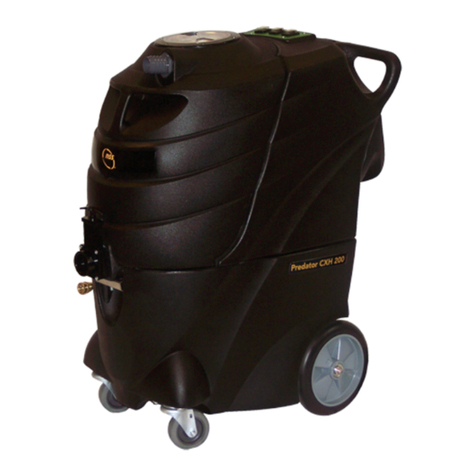
NSS
NSS CXC 200 User manual
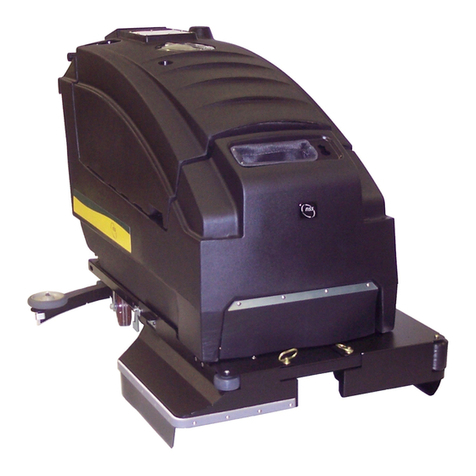
NSS
NSS Wrangler 3330 DB User manual
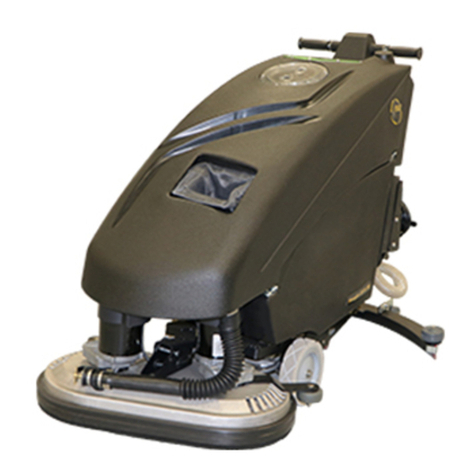
NSS
NSS WRANGLER 2616 DB User manual
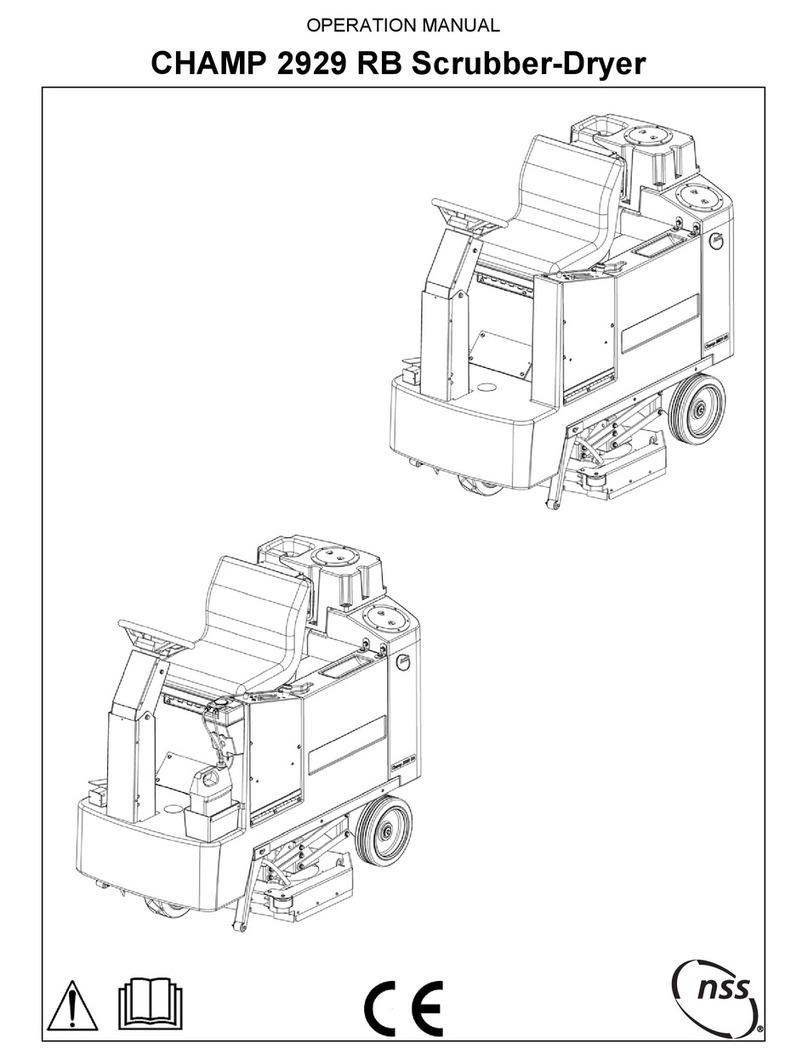
NSS
NSS champ 2929 rb User manual

NSS
NSS eForce 26 User manual

NSS
NSS CHAMP 2417 RB User manual
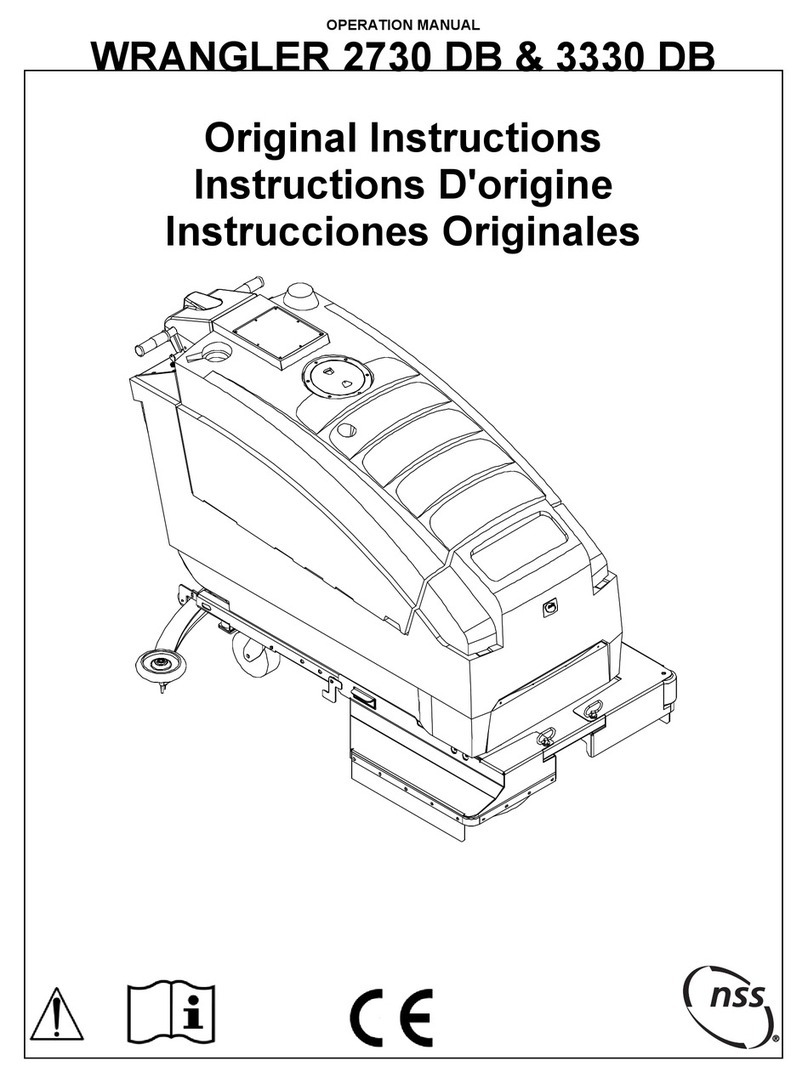
NSS
NSS Wrangler 3330 DB User manual
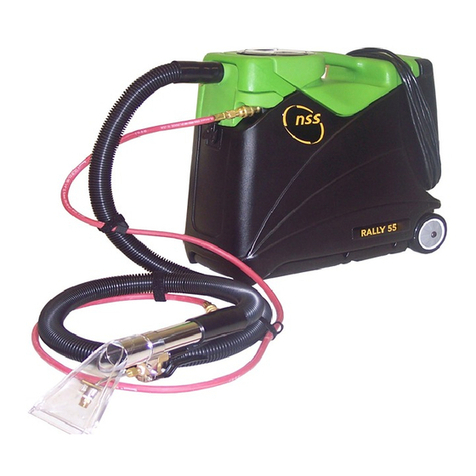
NSS
NSS Rally 55 User manual
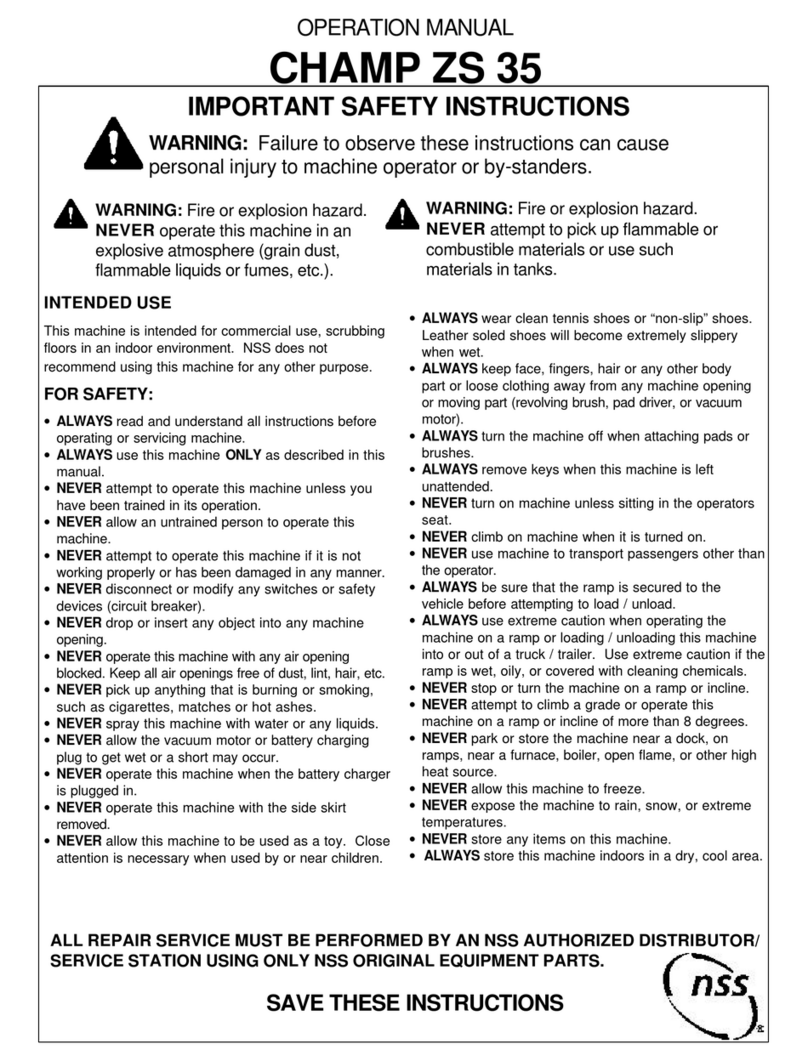
NSS
NSS CHAMP ZS 35 User manual
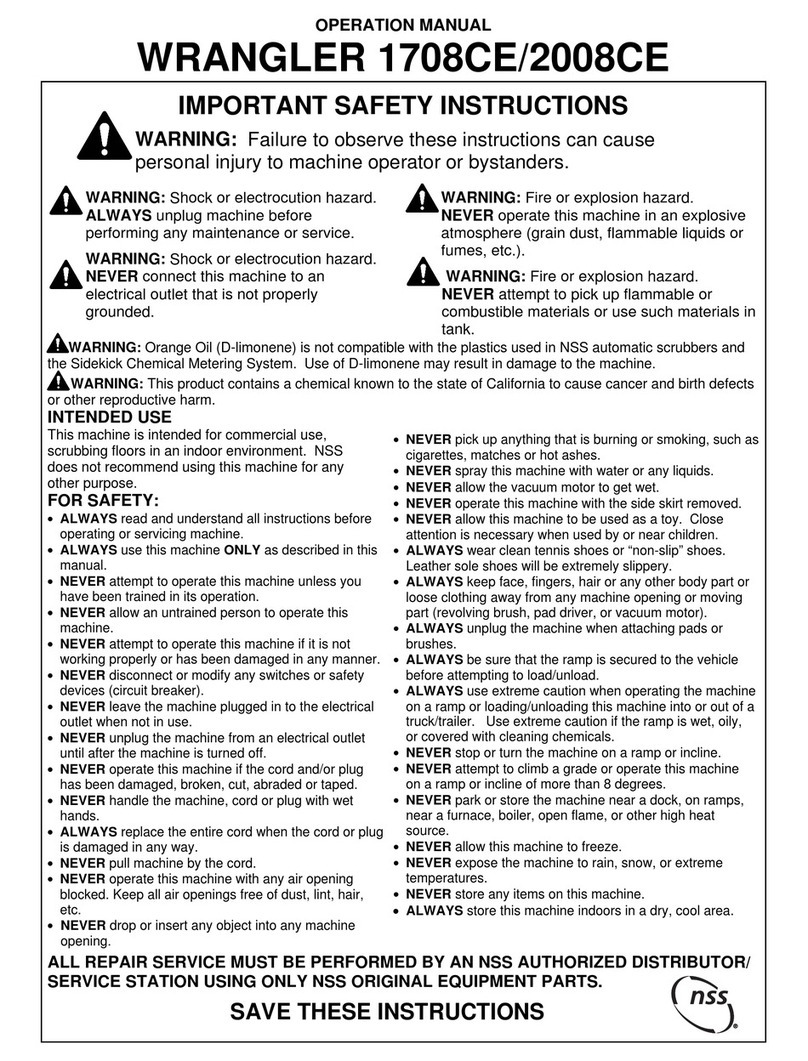
NSS
NSS WRANGLER 1708CE User manual
